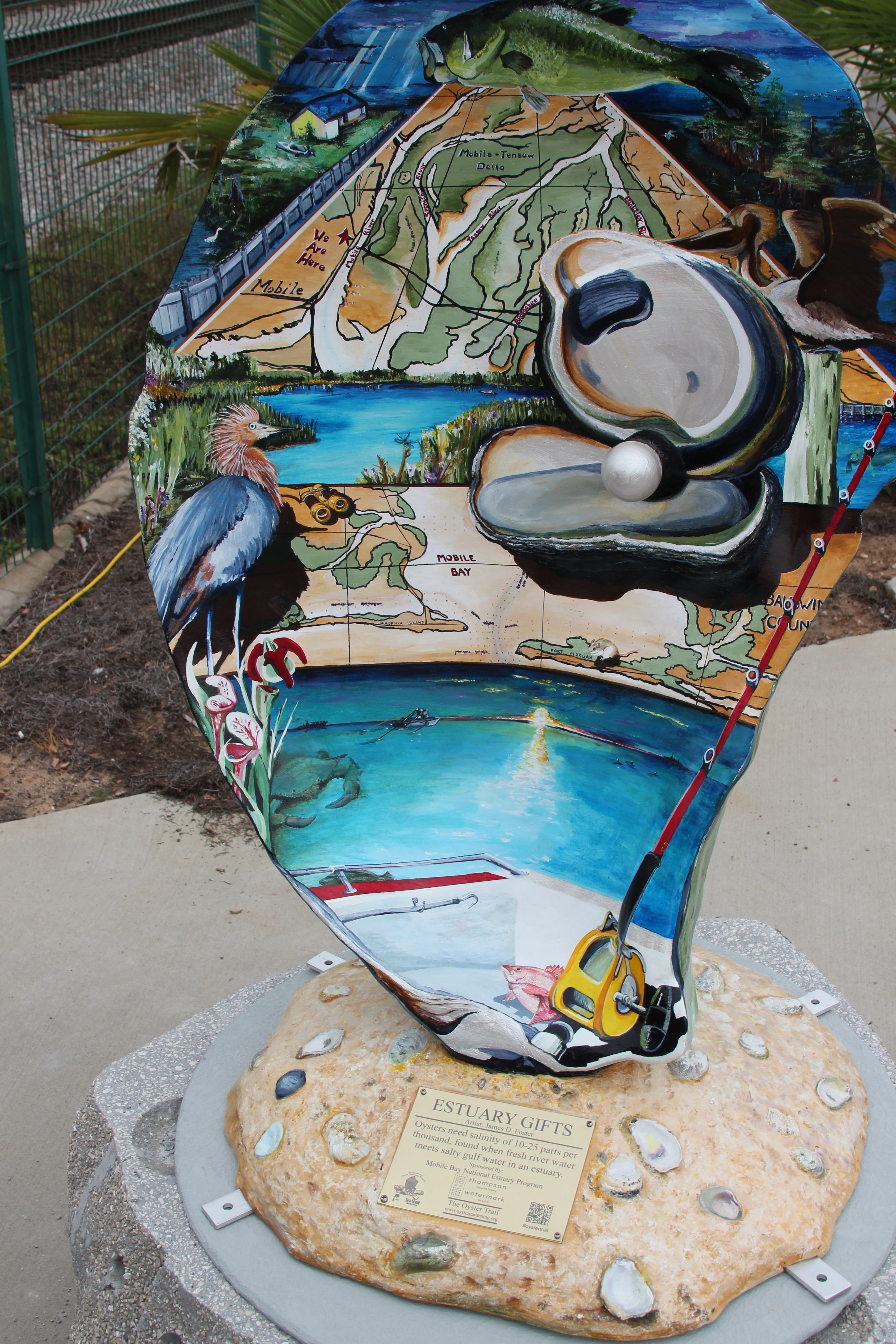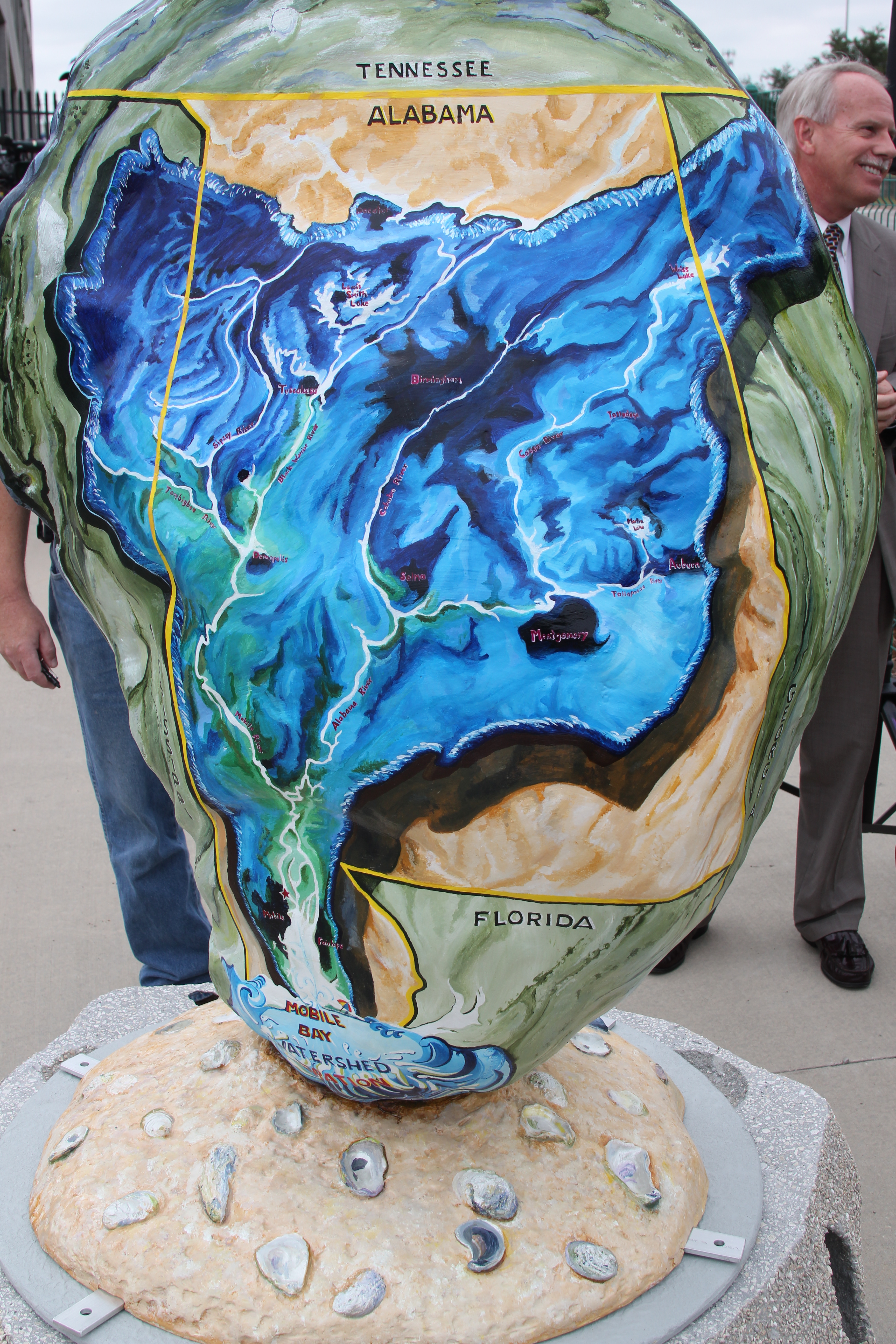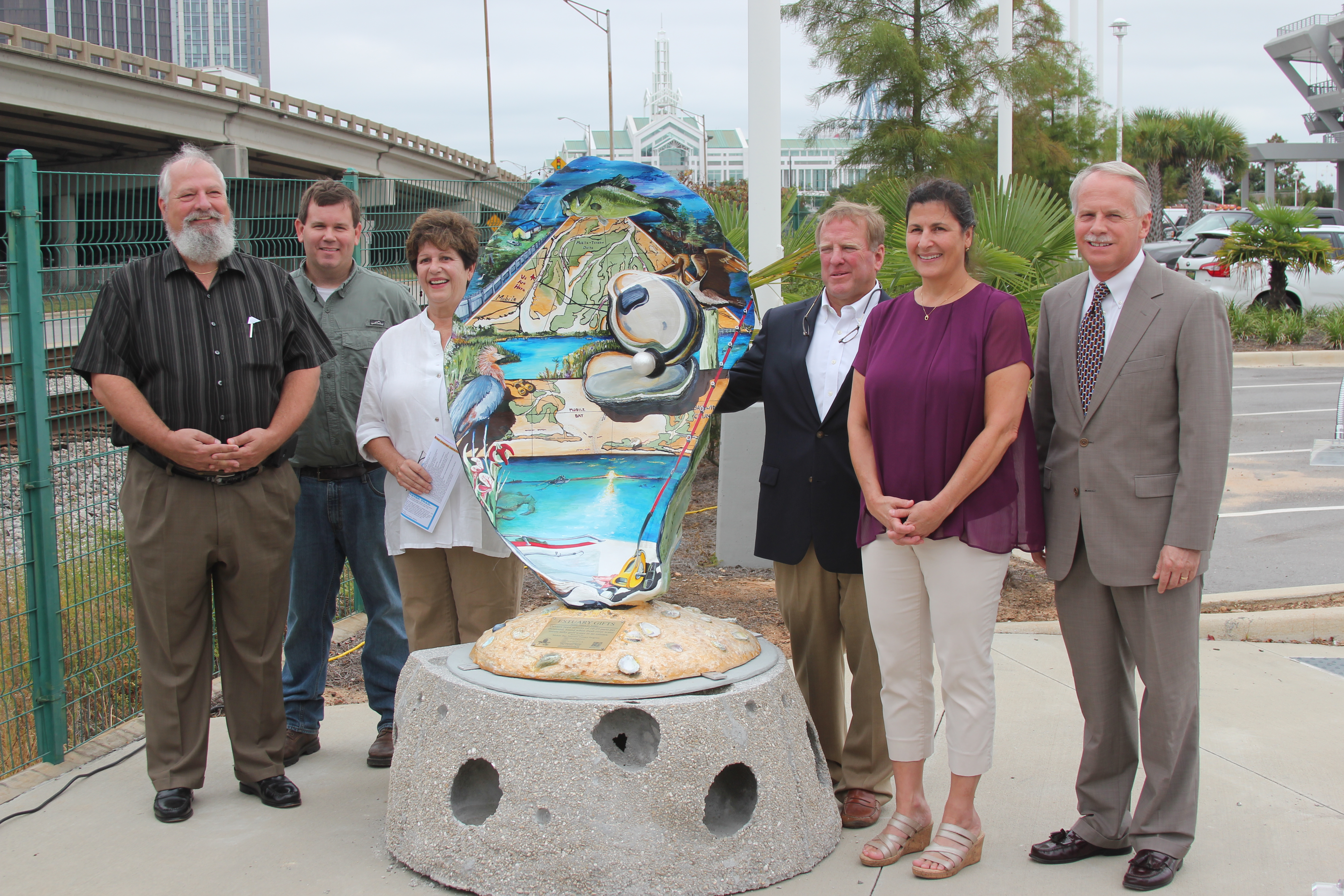Oyster unveiling at the GulfQuest Maritime Museum
Photo Gallery
By Jeff Dute
The 26th overall and 13th placed in downtown Mobile, the new installment of The Oyster Trail was unveiled at the GulfQuest Maritime Museum on Sept. 17.
Co-sponsored by the Mobile Bay National Estuary Program and Thompson Engineering/Watermark Design, “Estuary Gifts” was painted by native Mobilian James Foster.
On its face, Foster has painted extraordinarily vivid scenes depicting the varied topography and biology of the lower reaches of the Mobile Bay watershed that make it possible for it to support some of the most unique plants, animals and birds on the planet. A focal point of the shell’s inside scene panes is a three-dimensional pearl that Foster fashioned to scale where it rests inside a freshly opened Mobile Bay oyster.
On the outer shell, Foster’s painting of the entire watershed provides a surprisingly stark reminder of “how much stuff comes this way” through two-thirds of Alabama’s extensive waterways large and small plus parts of Mississippi and Georgia. Foster, who has a full-time job, said it took a couple of months of part-time work from initial consultations with MBNEP Director Roberta Swann to complete the intricate scenes.
During the unveiling, Thompson/Watermark’s President John Baker said The Oyster Trail, along with the GulfQuest Maritime Museum provide greater opportunity to educate locals and visitors to Mobile alike about the importance of the environment and the importance of Mobile Bay to our economy.
“The health of Mobile Bay and surrounding watersheds is directly tied to the health of our communities and the quality of life we enjoy,” Baker said. “While I’m certainly not a marine biologist and I’m not trying to play one today, the oyster is an indicator species of the overall health of the bay. If we have poor water quality conditions in the bay, the oysters are the first to know it. As much as I like to eat “Blue point” oysters from the East Coast or Apalachicola Bay oysters from the Big Bend area of Florida, I much prefer to enjoy Mobile By area oysters and seafood.”
Left to right, Artist James Foster, PJ Waters Mobile Bay Oyster Gardening Program, Marie Dyson Oyster Trail, John Baker President Thompson Watermark, Roberta Swann Director Mobile Bay National Estuary Program, Tony Zodrow GulfQuest Maritime Museum Stand next to the latest edition to the Oyster Trail.
Baker added that the only way to ensure high water quality standards is to “promote sustainable, resilient and environmentally thoughtful design standards and practices throughout the built environment.”
The Oyster Trail is a fun, educational and public- art treasure hunt throughout coastal Alabama. Look for the large fiberglass oysters that have been painted, decorated and bedazzled by artists throughout the area and which can be found along the street, within parks in lobbies and other places.
Each oyster has a fact plaque that includes important information about the oyster’s ecological and economic benefit to Mobile Bay. Visitors to the trail are guided by a Trail Map which provides locations of the oysters.
Trail Maps can be found in hotels, shops, visitor centers, etc. or can be downloaded. Completed scavenger-hunt forms can be returned to win Oyster Trail prizes.
Through sponsor donations, The Oyster Trail not only teaches people about the importance of healthy oyster populations as it relates to water quality but the money is also used to fund the Mobile Bay Oyster Gardening Program. This volunteer-based program coordinated the Auburn University Shellfish on Dauphin Island focuses on education, restoration/enhancement and oyster research by “bringing the reef to the people.”
Gardeners receive oyster spat in early July and grow them in baskets hung from their wharves until late November when they average about 2.5 inches. Their oyster offspring are collected and planted on reefs that have been degraded by storms, sedimentation and other causes. Volunteer gardeners have grown nearly 600,000 advanced stocker oysters for planting in and around Mobile Bay over the past 15 years, said Program Coordinator P.J. Waters.
“Without the supporters, sponsors and artists who participate in The Oyster Trail, the Mobile Bay Oyster Gardening Program would not exist,” Waters said.
Director Roberta Swann said the MBNEP’s support of The Oyster Trail has been steadfast since its inception because it has on-the-water as well as educational benefits.
“Not only does this Oyster Trail generate money to continue the gardening program, it provides educational facts about the value of oysters in our estuary,” Swann said. “Not only can an adult oyster filter up to 50 gallons of water a day, oyster reefs provide habitat for other fish and shell fish. They can reduce wave energy in close proximity to the shore and most important, are at the very foundation of coastal Alabama heritage and culture.
“To secure a future of oysters in Alabama is vital to securing a healthy estuary and frankly, a tasty treat.”
To learn more about or become a Mobile Bay Oyster Gardening Program volunteer, go to http://www.oystertrail.com. To learn more about the Mobile Bay National Estuary Program’s efforts in watersheds across the area, go to http://www.mobilebaynep.com.
Jeff Dute is a communications consultant for Mobile Bay NEP







